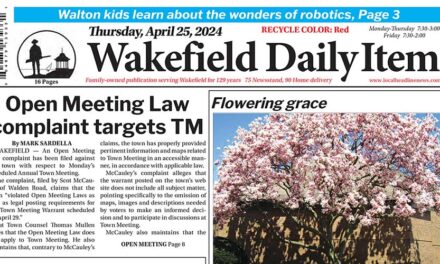Published in the July 30, 2019 edition.
WAKEFIELD — Massachusetts Municipal Light Plants (MLPs) are well ahead of the New England region and Massachusetts independent owner utilities (IOUs) with lower-emitting resource mixes, lower carbon emission portfolios, and proactive investments in advanced energy technologies, according to a study entitled “Fuel Mix and Greenhouse Gas Emissions of Municipal Light Plants in Massachusetts.”
The study, commissioned by the Municipal Electric Association of Massachusetts and conducted by Analysis Group, noted that approximately 94 percent of the power owned or contracted for by municipal light plants like the Wakefield Municipal Gas & Light Department (WMGLD) comes from a portfolio resource mix that does not emit greenhouse gases, including primarily wind, solar, hydro, and nuclear. Even when factoring in short-term market purchases, the effective MLP portfolio in 2017 was 75 percent non-emitting, resulting in a substantially greater share of non-emitting resources in the MLP portfolio than New England’s overall resource mix of 57 percent non-emitting.
Locally, according to WMGLD General Manager Pete Dion, 77 percent of Wakefield’s total energy is currently generated by resources that do not emit greenhouse gases.
“This study is a clear indication that municipal light plants are well on the way to fulfilling the mission of the Commonwealth of Massachusetts’ Global Warming Solutions Act mission of 80 percent reduction in carbon emissions by 2050,” Dion said.
According to the study, the emitting generation for MLPs represents over 40 percent less than the regional total (25 percent vs. 43 percent) and over 50 percent less than the IOUs (24 percent vs. 53 percent). Similarly, when comparing emissions profiles, the results are similar: the MLPs have a 40 percent lower emissions profile than the broader region, and a 60 percent lower emissions profile than the IOUs.
In addition to releasing its finding about MLPs role in reducing carbon emissions, the study’s report also highlighted the unique benefits of MLPs like WMGLD and how the benefits of community-owned utilities factor into their findings.
“The MLPs are not-for-profit vertically-integrated utilities that operate as a division of local government, are governed by local city councils or elected or appointed boards subject to voters’ views and expectations, and are fully embedded in the communities they serve,” the report noted. “Community ownership provides an opportunity for open citizen input into investment, operational and policy decisions governing local utility service, and for a direct and transparent line of accountability and oversight between the city’s or town’s citizens and the utility’s management and decisions that affect cost and reliability outcomes.
“These features drive the ability of the MLPs to pursue resource investment and operational decisions with an eye towards both local customer expectations and state policies and emission targets. And the MLPs can do this efficiently and proactively, given their direct access to local permitting and zoning processes and positive relationships with local government, access to low-cost capital, not-for profit viewpoint, and ability to approach resource planning for the long-term including an integrated view of utility operations (i.e., generation, transmission, and distribution).”
The Analysis Group also cited the proactive investments in energy efficiency programs the MLPs have successfully funded through grants and/or municipal funding, innovative energy programs that represent investments in cutting-edge technologies, and pilot programs for new and advanced energy initiatives.
“The study also recognized that the WMGLD and the 40 other municipal light plants have made significant progress in advanced energy technologies, out-pacing IOUs,” the general manager added. “Specifically, the report highlighted the EV (electric vehicle) programs such as Wakefield’s free EV Level Two Chargers as well as awareness and education funding; distributed solar, including the new incentives for solar installations, and net metering; and energy storage, something the WMGLD is particularly proud of in light of our new battery storage project at the Beebe substation.”
“We are pleased, but not surprised with the study’s findings,” the general manager concluded.
WMGLD customers can read the study and its finding on the website www.wmgld.com.




